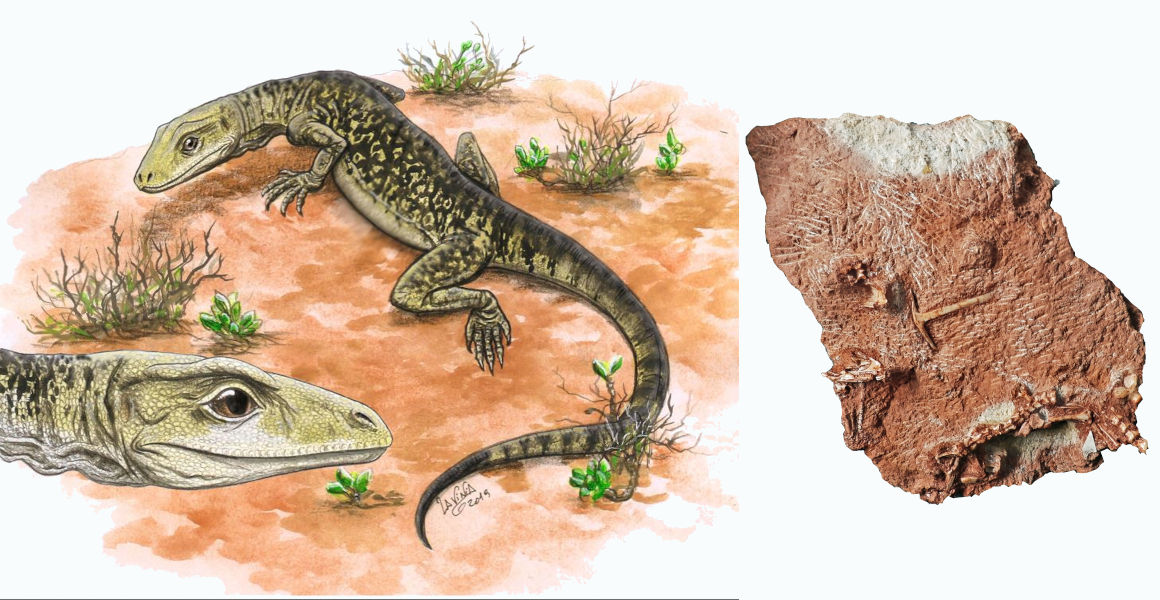
Gloucestershire fossil suggests modern lizards could have Triassic origins
A new species of extinct lizard has been described from the Museum’s collections.
With jaws lined with sharp, blade-like teeth, Cryptovaranoides microlanius has been christened with a name that translates as ‘small butcher’. Their teeth would have allowed it to capture and consume insects, spiders and small vertebrates that lived alongside it over 200 million years ago.
Its fossils lay buried in a South Gloucestershire quarry until they were discovered in 1953 by a team from University College London, later entering the Museum’s collections in the 1980s. With much of its body encased in rock, its true identity was unknown for decades until advances in scanning technology revealed its true form for the first time.
The researchers behind its description claim it is likely to become one of the most celebrated finds of the past few decades as it pushes back the origin of the squamates, the group of reptiles containing snakes and lizards, by over 30 million years.
Professor Mike Benton, who co-authored the description of the species, says, ‘This fossil shifts the origin and diversification of squamates back from the Middle Jurassic to the Late Triassic, when some of the first members of modern groups such as turtles, crocodilians and mammals arose.’
‘Adding the oldest modern squamates to this epoch completes the picture. It seems these new plants and animals came on the scene as part of a major rebuilding of life on Earth after the largest mass extinction in history and a period of climate fluctuation.’
Dr Marc Jones, the Museum’s Curator of Fossil Reptiles, adds that the discovery of any Triassic lizard is a ‘significant find.’
‘If this new species is part of the modern diversification of lizards, it is consistent with some studies that suggest it took place in the Triassic,’ Marc explains. ‘Nevertheless, further fossil species would be great to understand the details of how this took place.’
‘There are still quite big gaps in the fossil record, with parts of the world having no record at all for these animals. There isn’t very good sampling for rainforest or mountainous environments, for example, and this could skew our understanding of when these animals evolved.’
The findings of the study were published in the journal Science Advances.

Cromhall quarry is now used as a diving centre, and has been an important source of fossils in the UK. Image © Roger Cornfoot, licensed under CC BY-SA 2.0 via Geograph.
How was Cryptovaranoides microlanius discovered?
Southern England and Wales were very different places during the Late Triassic. At the time, the area around what is now Bristol and Cardiff is believed to have been part of an archipelago of small islands where dinosaurs such as Pendraig milnerae roamed.
Beneath their feet, Cryptovaranoides microlanius is thought to have lived among the cracks in the limestone that made up the islands. While these crevices would have provided safety from predators, they are also where this particular animal ultimately met its fate.
Buried in the crevice and covered over, its fossilised remains were preserved beneath the ground for over 200 million years.
This type of deposit, known as a fissure fill, are sometimes uncovered as part of quarrying in the Cardiff and Bristol area, with the site in Cromhall known to be a particularly rich source of fossils for species including Agnostiphys cromhallensis.
It was from this quarry that Cryptovaranoides microlanius was unearthed in the 1950s by Professor Pamela L. Robinson from University College London.
While she was able to partially prepare the specimen, and other bones from the species also found at the site, the risk of damaging the fossil and the limited scanning technology available at the time meant that the lizard’s identity remained a mystery.
It was stored in the Museum for many years until Dr David Whiteside, a scientific associate at the Museum, renewed and led the research into the new species.
‘The specimen was located in a cupboard full of Clevosaurus fossils,’ David says. ‘Clevosaurus was a common enough fossil reptile and a close relative of New Zealand’s tuatara, the only survivor of a group of reptiles known as the rhychocephalians.’
‘The Cryptovaranoides specimen was simply labelled as "Clevosaurus and one other reptile." As myself and my colleagues continued to investigate the specimen, we became increasingly convinced that it was actually more closely related to modern day lizards than the rhynchocephalians.’
X-ray scans of the fossils allowed the researchers to digitally reconstruct the animal and reveal the bones hidden inside the rock. The shape of the skull and its teeth are among the characteristics that suggest it is a modern lizard rather than a relative of the tuatara.
Comparisons with other species suggest its closest relatives include the Gila monster and monitor lizards, and the fossil could provide additional knowledge about how these reptiles relate to each other.
It also hints that the rise of reptiles in the Triassic might be related to a specific episode in Earth’s history, the Carnian Pluvial Episode (CPE).

Its sharp teeth would have allowed the lizard to prey on a range of invertebrates and small vertebrates. Image © Lavinia Gandolfi/David Whiteside, Sophie Chambi-Trowell, Mike Benton and the Natural History Museum, London.
What is the Carnian Pluvial Episode?
The Carnian Pluvial Episode was a period of climate change that took place around 232 million years ago, which is believed to have been caused by volcanic eruptions in what is now Alaska and Canada.
Rising temperatures led to periods of intense rainfall in what were otherwise very dry environments, causing lakes and rivers to swell in size. As the world became more humid, environmental change occurred across the world and species that couldn’t adapt were driven to extinction.
In the sea, marine invertebrates, such as ammonites, fared badly as around a third of species were wiped out, while on land, herbivorous animals such as the dicynodonts also suffered significant declines.
This left niches for other animals to evolve into, with some research linking the CPE to the diversification of the dinosaurs as new species rapidly evolved. Others, however, have found limited or no evidence that the CPE had an impact.
‘The CPE involved a shift from arid to humid environments worldwide.’ Marc explains. ‘As a result, it could have had a big effect on the environment of many species, including lizards. This could have changed their potential prey and habitat, which would in turn have impacted the evolution of lizards.’
The description of C. microlanius adds support for the impact of the CPE on the diversification of life, at least in Europe. The researchers propose in the paper that the event could have led to new species of lizards and snakes rapidly evolving.
After around two million years, the CPE came to an end and the world returned to a more arid state. Lizards and snakes remained established, however, and continued to diversify with further bursts of evolution in the Cretaceous and after the extinction of the dinosaurs.
Marc suggests that directing more research into the skeletons of living animals could help to reveal some of the changes that drove their diversification.
‘We still don’t know enough about modern animals and their skeletons, and this hampers our ability to interpret the fossil record,’ Marc says. ‘A lot of characters used to study extinct species are related to the skull and teeth, but there are other bones which are often overlooked which might have interesting stories to tell.’
The evolutionary timings suggested by C. microlanius could also add other pieces to this puzzle, shedding more light on the key moments in the evolution of the squamates.








































